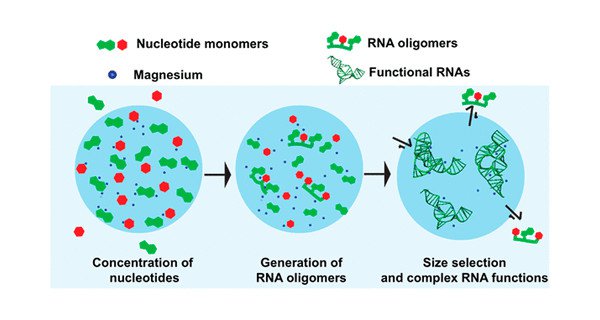
June 18, 2018
Research Highlight
'Bioreactors' in the RNA World
The potential role of of RNA-containing, membraneless compartments

Tiny liquid droplets may have concentrated precious biomolecules and acted as bioreactors in the RNA World.Image credit: Poudyal et. al. (2018).
A recent study examines how RNA in membraneless compartments may have played a role in prebiotic chemistries relevant to the origin of life on Earth. One theory of life’s origins, the ‘RNA World,’ posits that RNA could have played a role in early life by acting to both store genetic information and to act as a catalyst in chemical reactions.
The study focuses on compartments that are both biological and nonbiological, and form from liquid-liquid phase separation (LLPS). In living cells, liquid condensates that are rich in RNAs can form, and these provide spatial regulation of interactions between biomolecules in cells. This form of LLPS happens with a number of biogenic and abiogenic molecules. Under the right conditions, RNA is one such molecule. LLPS could have been a mechanism for concentrating components used to form RNA, and also to selectively separate RNAs that catalyzed chemical reactions.
In their paper, the research team discusses different types of LLPS and the potential role of each in prebiotic chemistry. They conclude that ‘tiny liquid droplets may have concentrated precious biomolecules and acted as bioreactors in the RNA World.’
The study, “Physical Principles and Extant Biology Reveal Roles for RNA-Containing Membraneless Compartments in Origins of Life Chemistry,” was published in the journal Biochemistry. The work was supported by NASA Astrobiology through the Exobiology Program.